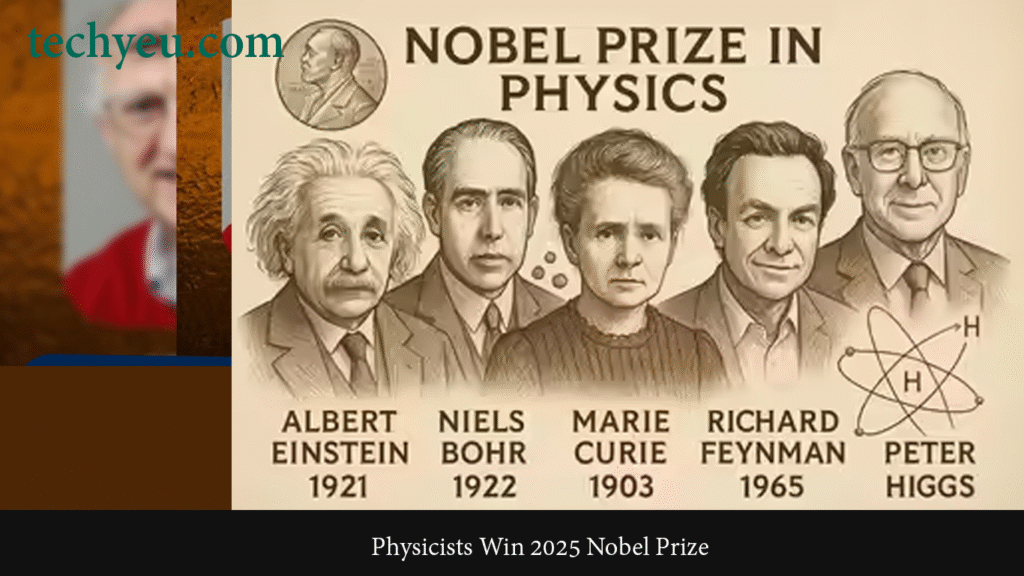Three Physicists Awarded 2025 Nobel Prize for Quantum Mechanics Breakthrough
Stockholm, Sweden — Three U.S.-based physicists — John Clarke, Michel H. Devoret, and John M. Martinis — have been awarded the 2025 Nobel Prize in Physics for their groundbreaking experiments that proved quantum mechanics can operate in electrical circuits large enough to be seen and measured. Physicists John Clarke, Michel Devoret and John M. Martinis were awarded the 2025 Nobel Prize in Physics due to the discovery of macroscopic quantum tunnelling and quantisation of energy in an electrical circuit.
Royal Swedish Academy of Sciences announced the award on Tuesday, honoring the trio “for the discovery of macroscopic quantum mechanical tunnelling and energy quantisation in an electric circuit.”
Quantum Effects on a Human Scale
Their pioneering research, first conducted in the 1980s, demonstrated that the strange principles of quantum physics — long thought to apply only to atoms and subatomic particles — could also appear in man-made, visible electrical systems under specific conditions.
Quantum tunnelling is one of the most unusual phenomena in physics. It allows particles to pass through barriers that classical physics would deem impossible. Clarke, Devoret, and Martinis created a superconducting circuit cooled to near absolute zero, enabling this phenomenon to occur in measurable systems.
By employing Josephson junctions — two superconductors separated by a thin insulator — the scientists showed that electrical currents could “tunnel” through barriers, revealing unmistakably quantum behavior in a macroscopic setting. The circuits also absorbed and released energy in fixed quantities, or “quanta,” confirming long-standing quantum theory predictions.
“It is wonderful to celebrate how century-old quantum mechanics continues to reveal new surprises,” said Olle Eriksson, Chair of the Nobel Committee for Physics. “It remains enormously useful, forming the foundation of all digital technology.”
Laying the Groundwork for the Quantum Future
The trio’s groundbreaking work laid the foundation for superconducting quantum circuits — the core of today’s quantum computers, sensors, and communication systems.
Quantum computing relies on qubits, which can exist in multiple states simultaneously, allowing massive data processing and solving problems far beyond the capacity of traditional computers.
Leading technology companies, including Google and IBM, use superconducting qubits — direct descendants of the systems pioneered by Clarke, Devoret, and Martinis — in the race to develop practical quantum computers. Their work continues to influence advances in quantum cryptography, quantum sensors, and next-generation computing.
“The Surprise of My Life”
Reacting to the announcement, John Clarke, a British-born professor at the University of California, Berkeley, said he was “completely stunned” to receive the Nobel honor.
“Of course, it had never occurred to me that this might be the basis of a Nobel Prize. To put it mildly, it was the surprise of my life,” Clarke told the Nobel press conference. “One of the reasons cell phones work today is because of all this foundational research.”
His co-winners, Michel Devoret — a French-born professor at Yale University and Chief Scientist at Google Quantum AI — and John Martinis, formerly head of Google’s Quantum Artificial Intelligence Lab, also expressed joy and surprise at the recognition. Martinis’s lab famously claimed to achieve “quantum supremacy” in 2019.
Paving the Way for the Quantum Age
The three laureates will equally share the 11 million Swedish kronor (approximately $1.17 million USD) prize. The award will be presented by the King of Sweden at a ceremony in Stockholm on December 10, the anniversary of Alfred Nobel’s death.
This year’s Nobel Prize in Physics highlights a historic transition — the moment when quantum theory leaped from abstract science into real-world applications, forming the foundation of modern digital and computing revolutions.
Their work not only deepened scientific understanding but also laid the foundation for the quantum technologies powering the future — from faster computing to secure global communications.

